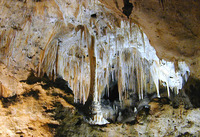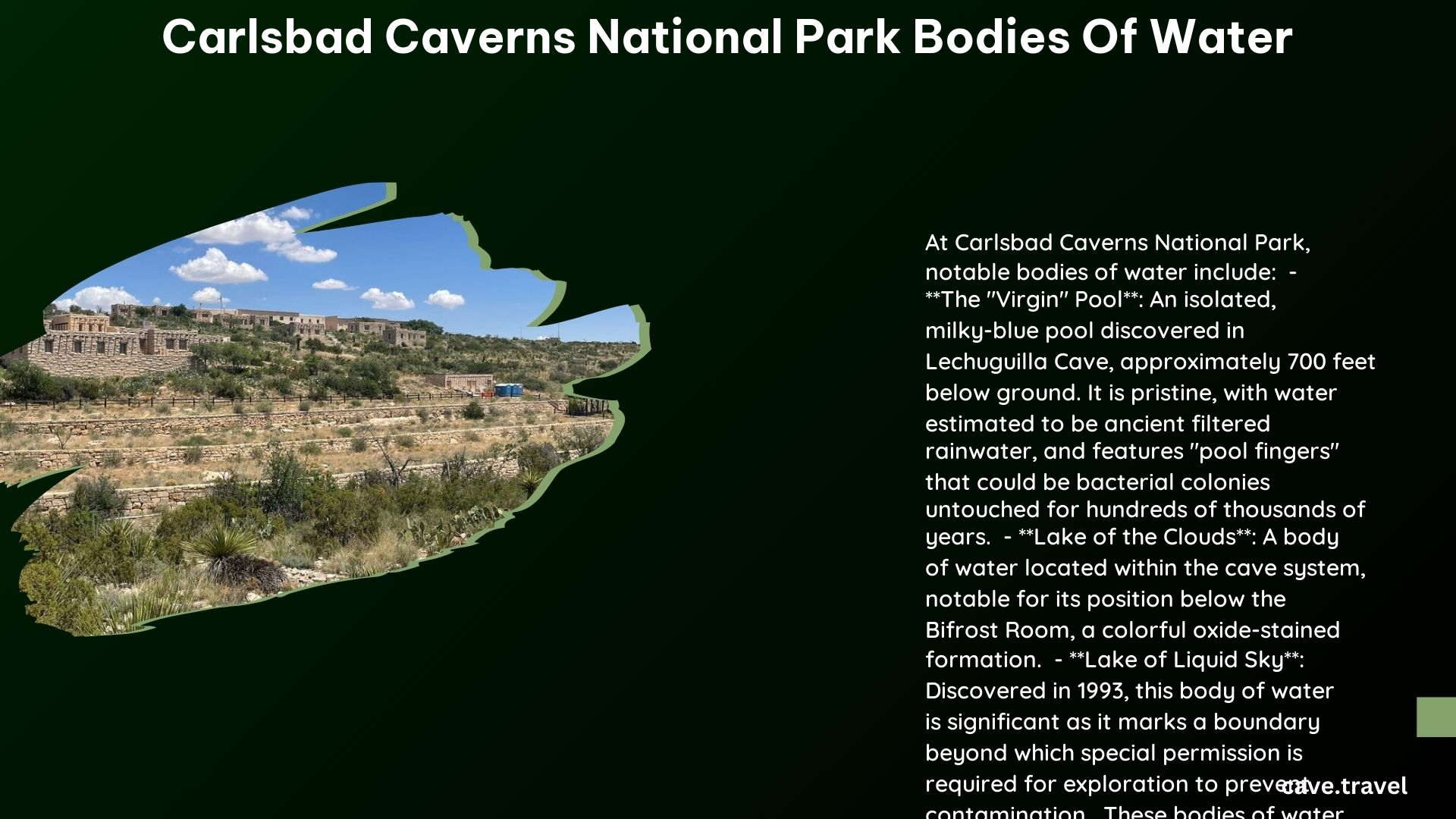Carlsbad Caverns National Park, located in southeastern New Mexico, is renowned for its extensive cave system. While it lacks large underground lakes, the park features a complex hydrological system crucial to its formation and ecosystem. Groundwater, seepage, and mineral-rich water droplets play vital roles in shaping the caverns and supporting unique cave-dwelling species. The park’s water features, though not expansive, are integral to its geological and ecological characteristics.
What Are the Main Water Features in Carlsbad Caverns?

Carlsbad Caverns National Park’s water features are primarily characterized by:
- Groundwater seepage
- Mineral-rich water droplets
- Flowstone formations
- Dripstone formations (stalactites and stalagmites)
These water features contribute to the ongoing formation of the caverns and support the unique ecosystem within.
How Does Water Shape the Caverns?

Water plays a crucial role in shaping Carlsbad Caverns through several processes:
-
Dissolution: Groundwater, enriched with carbonic acid from surface vegetation, dissolves limestone, creating and expanding cave passages.
-
Speleothem Formation: Mineral-rich water droplets slowly deposit calcium carbonate, forming various cave formations:
- Stalactites (hanging from the ceiling)
- Stalagmites (growing from the floor)
- Columns (where stalactites and stalagmites meet)
-
Flowstone (sheet-like deposits on walls and floors)
-
Erosion: Water flow can erode softer rock layers, creating unique cave features and passages.
What Unique Species Inhabit the Caverns’ Water Ecosystem?
The water ecosystem within Carlsbad Caverns supports a variety of specialized species:
| Species Type | Examples |
|---|---|
| Fish | Cave-adapted blind fish |
| Amphibians | Cave salamanders |
| Invertebrates | Cave beetles, spiders, and crustaceans |
These organisms have evolved unique adaptations to thrive in the dark, stable environment of the caves, including:
- Loss of pigmentation
- Reduced or absent eyes
- Enhanced sensory organs
- Slow metabolism
How Does the Park’s Hydrology Function?
The hydrology of Carlsbad Caverns is characterized by:
- Water Sources:
- Groundwater seepage through limestone bedrock
-
Rainwater and snowmelt percolation
-
Flow Patterns:
- Slow, steady water movement through porous limestone
-
Gravitational pull directing water downward
-
Seasonal Variations:
- Slight changes in water input based on surface precipitation
- Relatively stable underground environment
What Conservation Efforts Protect the Caverns’ Water System?
The National Park Service implements several measures to protect Carlsbad Caverns’ delicate water system:
-
Access Control: Strict regulations on visitor numbers and activities within the caves.
-
Pollution Prevention:
- Monitoring surface activities to prevent groundwater contamination
-
Controlling runoff from parking lots and facilities
-
Ecosystem Monitoring:
- Continuous tracking of air quality, temperature, and humidity
-
Regular assessment of cave formation growth rates
-
Research Regulations: Guidelines for scientific studies to minimize impact on the cave environment.
-
Species Protection: Measures to safeguard unique cave-dwelling organisms and their habitats.
How Do Water Features Contribute to the Caverns’ Aesthetic Appeal?
The water features in Carlsbad Caverns contribute significantly to its visual beauty:
- Speleothem Diversity: Water creates a wide array of formations, including:
- Delicate soda straws
- Massive draperies
-
Intricate helictites
-
Reflective Surfaces: Still pools of water create mirror-like surfaces, enhancing the cave’s visual depth.
-
Dynamic Formations: Active water flow creates ever-changing formations, ensuring the cave’s appearance evolves over time.
-
Lighting Effects: Water droplets and wet surfaces interact with cave lighting to create sparkling, ethereal effects.
What Role Does Water Play in the Caverns’ Microclimate?
Water is crucial in maintaining Carlsbad Caverns’ unique microclimate:
-
Temperature Regulation: Water helps maintain a stable temperature of around 56°F (13°C) year-round.
-
Humidity Control: Constant water presence keeps humidity levels high, typically around 90%.
-
Air Circulation: Water movement influences air currents within the cave system.
-
Mineral Transport: Dissolved minerals in water contribute to the chemical composition of cave air.
This stable microclimate is essential for the preservation of cave formations and the survival of cave-dwelling species.
How Does Surface Water Affect the Caverns?
Surface water impacts Carlsbad Caverns in several ways:
-
Recharge: Rainwater and snowmelt percolate through soil and rock, replenishing the groundwater that feeds the cave system.
-
Erosion: Surface water runoff can affect the landscape above the caves, potentially altering water infiltration patterns.
-
Contamination Risk: Pollutants from surface activities can be carried into the cave system by water, posing a threat to the delicate ecosystem.
-
Seasonal Variations: Changes in surface precipitation can affect the rate of water input to the caves, influencing formation growth and ecosystem dynamics.
By understanding these complex interactions between surface and underground water systems, park managers can better protect and preserve the unique environment of Carlsbad Caverns National Park.
References:
1. National Park Service – Carlsbad Caverns
2. USGS – Hydrogeology of the Carlsbad Caverns
3. Journal of Cave and Karst Studies – Carlsbad Cavern Pool Geochemistry
